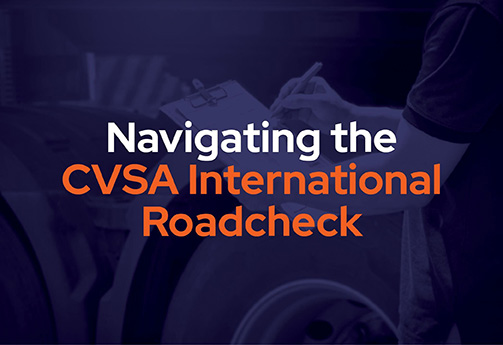Navigating the CVSA International Roadcheck

Are you prepared for the upcoming Commercial Vehicle Safety Alliance (CVSA) International Roadcheck taking place May 14-16? Last year, inspectors found out-of-service violations on 19% of vehicles, leading to 11,270 vehicles being removed until violations were corrected.
This year, the International Roadcheck will focus on two areas: Tractor Protection Systems and Alcohol & Controlled Substance Possession.
Tractor Protection and Anti-Bleed Back Systems
Inspectors will test tractor protection valves, trailer supply valves, and anti-bleed back valves during roadside inspections. During the inspection of tractor protection system components, the inspector will:
- Ensure the wheel chocks are still in place and have the driver release all the brakes by pressing dash valves.
- Have the driver carefully remove the gladhands and allow air to escape.
- Ensure the air stops leaking from the supply line with at least 20 psi remaining.
- Listen and/or feel for any leaking air at the gladhand couplers on the trailer.
- Request a full-service brake application by the driver.
- Listen and/or feel for leaks from both air lines.
Controlled Substance and Alcohol Possession
Inspectors will:
- Observe the driver for signs of alcohol or controlled substance use and/or impairment.
- Examine the cab and trailer for alcohol or controlled substances.
- Conduct a query in the DACH (for inspections in the U.S.). Now is the time to inspect and repair any equipment deficiencies, and remind drivers of FMCSA regulations and your company’s drug and alcohol policies.
In addition to the two focus areas, comprehensive North American Standard Level I inspections will be conducted throughout the three-day event. Drivers should be prepared for all areas of the 37-step inspection, which covers the vehicle’s brake systems, cargo securement, coupling devices, driveline/driveshaft components, driver’s seat, fuel and exhaust systems, frames, lighting devices, steering mechanisms, suspensions, tires, wheels, rims, hubs, and windshield wipers.
In 2023, during the 72 hours of International Roadcheck, inspectors performed 59,429 inspections, and 19% of the vehicles looked at had at least one out-of-service violation. The following steps will help ensure a smooth inspection process:
- Review Federal Motor Carrier Safety Regulations (FMCSRs): Relevant regulations concerning Tractor Protection Systems. For the tractor protection system testing procedure, review the inspection bulletin, and check out CVSA’s informational flyer on this year’s focus areas.
- Check paperwork: Verify important documents such as CDL, registration, insurance, BOLs, and permits are current and easily accessible.
- Complete pre-trip inspection: Before you hit the road, perform a comprehensive vehicle check. Inspect the brakes, tires, lights, and other essential parts to ensure they function properly.
- Verify load securement: Check for damage to straps or ratchets, properly secure Hazmat cargo, and ensure the load does not exceed the vehicle’s weight limit. To avoid violations, load securement devices must be labeled with their load capacity.
- Inspect synthetic webbing straps for damage: Any separation in the stitched area exceeding 1/4 of the total warrants removal from service. Tie-downs should not have knots or repairs; tensioning devices can not bend due to damage.
- Check the ABS system: Pay close attention to ABS lights, wheel speed sensor cables, brake linings, drum condition, air leaks, brake adjustment, and springs in brake chambers.
- Inspect chains for wear: Chains can’t have bent, worn, or twisted links and cannot be worn more than 20% of their original thickness.
- Stay informed about regulations: Attend training sessions and seminars to stay updated on safety regulations and requirements.
- Train drivers: Provide thorough training on inspection requirements and handling of violations to ensure drivers feel confident and prepared.
- Promote a culture of safety: Prioritize safety within your organization and hold all employees accountable for following safety protocols and regulations. At HDVI we assign dedicated Fleet Services Representatives for each customer to support your culture of safety and reduce risk.
By following these tips, you can help ensure that your commercial vehicle passes the CVSA International Roadcheck with flying colors. Remember, safety is always the top priority, and it’s essential to take the necessary steps to protect yourself and others on the road. For more information about this year’s roadcheck, visit: https://www.cvsa.org/news/2024-international-roadcheck/


